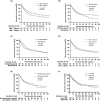Body composition is associated with postoperative complications in perihilar cholangiocarcinoma
- PMID: 38164056
- PMCID: PMC10807576
- DOI: 10.1002/cam4.6878
Body composition is associated with postoperative complications in perihilar cholangiocarcinoma
Abstract
Background: Perihilar cholangiocarcinoma (pCCA) is a malignant tumor of the hepatobiliary system which is still associated with a challenging prognosis. Postoperative complications play a crucial role in determining the overall prognosis of patients with pCCA. Changes in body composition (BC) have been shown to impact the prognosis of various types of tumors. Therefore, our study aimed to investigate the correlation between BC, postoperative complications and oncological outcome in patients with pCCA.
Methods: All patients with pCCA who underwent curative-intent surgery for pCCA between 2010 and 2022 were included in this analysis. BC was assessed using preoperative computed tomography and analyzed with the assistance of a 3D Slicer software. Univariate and multivariate binary logistic regression analyses were conducted to examine the relationship between BC and clinical characteristics including various measurements of postoperative complications and Cox regressions and Kaplan-Meier analysis to evaluate oncological risk factors in the study cohort.
Results: BC was frequently altered in patients undergoing curative-intent liver resection for pCCA (n = 204) with 52.5% of the patients showing obesity, 55.9% sarcopenia, 21.6% sarcopenic obesity, 48.5% myosteatosis, and 69.1% visceral obesity. In multivariate analysis, severe postoperative complications (Clavien-Dindo ≥3b) were associated with body mass index (BMI) (Odds ratio (OR) = 2.001, p = 0.024), sarcopenia (OR = 2.145, p = 0.034), and myosteatosis (OR = 2.097, p = 0.017) as independent predictors. Furthermore, sarcopenia was associated with reduced overall survival (OS) in pCCA patients (sarcopenia vs. no-sarcopenia, 21 months vs. 32 months, p = 0.048 log rank).
Conclusions: BC is highly associated with severe postoperative complications in patients with pCCA and shows tendency to be associated impaired overall survival. Preoperative assessment of BC and interventions to improve BC might therefore be key to improve outcome in pCCA patients undergoing surgical therapy.
Keywords: body composition; cholangiocellular carcinoma; oncological outcome, perioperative complications.
© 2023 The Authors. Cancer Medicine published by John Wiley & Sons Ltd.
Conflict of interest statement
The authors of this manuscript have no conflict of interest to declare.
Figures




Similar articles
-
The prognostic impact of preoperative body composition in perihilar and intrahepatic cholangiocarcinoma.Hepatol Commun. 2022 Sep;6(9):2400-2417. doi: 10.1002/hep4.2004. Epub 2022 May 26. Hepatol Commun. 2022. PMID: 35616275 Free PMC article.
-
Postoperative factors predicting outcomes in patients with Perihilar cholangiocarcinoma undergoing curative resection-a 10-year single-center experience.Scand J Gastroenterol. 2025 Jan;60(1):73-80. doi: 10.1080/00365521.2024.2443515. Epub 2024 Dec 18. Scand J Gastroenterol. 2025. PMID: 39692292
-
Association between the Achievement of Textbook Outcomes in Liver Surgery and Overall Survival in Perihilar Cholangiocarcinoma Patients following Major Hepatectomy: A Multicenter Study.Dig Dis. 2025;43(2):179-189. doi: 10.1159/000543439. Epub 2025 Jan 8. Dig Dis. 2025. PMID: 39778550
-
Prognostic impact of liver resection side in peri-hilar cholangiocarcinoma: A systematic review and meta-analysis.Surg Oncol. 2024 Oct;56:102113. doi: 10.1016/j.suronc.2024.102113. Epub 2024 Jul 31. Surg Oncol. 2024. PMID: 39096574
-
A meta-analysis of prognostic factors for early recurrence in perihilar cholangiocarcinoma after curative-intent resection.Eur J Surg Oncol. 2023 Nov;49(11):106982. doi: 10.1016/j.ejso.2023.07.008. Epub 2023 Jul 10. Eur J Surg Oncol. 2023. PMID: 37487828 Review.
Cited by
-
Perioperative and Oncological Outcome in Patients Undergoing Curative-Intent Liver Resection for Cholangiocarcinoma in the Context of Osteopenia.Cancers (Basel). 2025 Jul 1;17(13):2213. doi: 10.3390/cancers17132213. Cancers (Basel). 2025. PMID: 40647511 Free PMC article.
-
Clinical features and prediction of long-term survival after surgery for perihilar cholangiocarcinoma.PLoS One. 2024 Jul 1;19(7):e0304838. doi: 10.1371/journal.pone.0304838. eCollection 2024. PLoS One. 2024. PMID: 38950006 Free PMC article.
-
Impact of imaging-diagnosed sarcopenia on outcomes in patients with biliary tract cancer after surgical resection: a systematic review and meta-analysis.World J Surg Oncol. 2024 Sep 2;22(1):229. doi: 10.1186/s12957-024-03516-0. World J Surg Oncol. 2024. PMID: 39218917 Free PMC article.
References
Publication types
MeSH terms
Grants and funding
LinkOut - more resources
Full Text Sources
Medical

